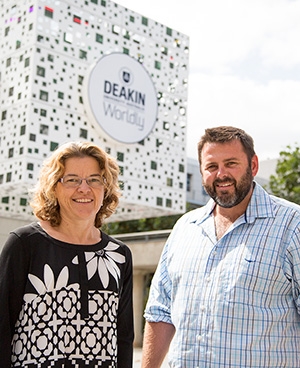Making every drop count
Research news
Whether it be using lasers to level paddocks, or sensors and satellites to manage water use, a raft of new approaches are now being used in Australian agriculture to make every drop of water count and allow every crop to thrive in an unpredictable climate.
Two of the nation’s top researchers in irrigation and sustainable land use, Dr John Hornbuckle and Dr Wendy Quayle, have joined Deakin’s Centre for Regional and Rural Futures (CeRRF).
The two have been at the heart of developments over the past 15 years that have seen Australian rice farmers reduce their water consumption by around 60 per cent and double their yields, and cotton growers and vineyards transform their productivity.
The appointments will help to position CeRRF as Australia’s premier research centre for agricultural productivity, in areas ranging from food and food security, to smart agriculture, to sustainable industrial biotechnology, through collaborating teams from engineering, science, business, economics and the humanities.
Established only last year, CeRRF now employs 11 researchers full-time and calls on another 11 associate researchers from across the university.
Dr Hornbuckle and Dr Quayle will continue to operate out of the Hanwood site in Griffith, where they have established many links over the past decade. In southern NSW, Griffith is at the centre of irrigated agriculture in the Murray Darling Basin, which accounts for around 40 per cent of Australia’s agricultural profitability.
“We are fortunate to have acquired two brilliant researchers from a highly productive part of Australia,” said Dr Julie Nicol, Acting Director of CeRRF.
“There are many areas where cross-fertilisation with other Deakin researchers can take place, in areas ranging from logistics (to help with distribution), to engineering (through developing and installing systems), through to our experts in agricultural and environmental science.”
Dr Hornbuckle said that Australia is likely to play an important role in helping farmers around the world adapt to climate change.
“We understand that successful agriculture is about being flexible, adjusting to the weather systems and growing crops accordingly,” he said.
“Farming is one of the most adaptable industries in the world. We have improved our rice yields from five tonnes per hectare to 11-12 tonnes per hectare in the past two decades. Through really good research and development, we can improve on this, and help other countries to improve their productivity and feed growing populations in changing climates.”
An irrigation and drainage engineer, Dr Hornbuckle leads a range of national and international irrigation research projects. He is the project leader for the IrriSAT Satellite Irrigation Water Management program, which is being used by cotton and viticulture industries to aid water management and benchmark irrigation productivity. The web-based system uses both satellite images and local weather data to monitor crop water use and detect crop growth variability, which allows irrigators to adjust watering regimes to save water and maximise yields.
Dr Hornbuckle and Dr Quayle have also been involved for a number of years in improving irrigation systems in Cambodia and Laos, through the Australian Centre for International Agricultural Research (ACIAR).
They have even introduced small scale laser levelling in these countries, which they adapted from technology used by Australian farmers to smooth land and reduce the irrigation water needs of crops.
Amongst her projects as an environmental chemist, Dr Wendy Quayle has led the development of a wastewater management system that is now used by Griffith wineries to ensure sustainable wastewater irrigation and improved pH control processes.
Dr Quayle is also leading projects on the mitigation of agricultural greenhouse gas emissions, through the optimisation of nitrogen use in irrigated crops, for instance, and through turning agricultural by-products, such as straw residues, into high value products.
She is already developing a collaboration with Deakin researchers on using enzymes on straw residues to extract microbial oil, which has strong potential as a source of Omega 3.
The two researchers recently visited each Deakin campus, as part of their induction.
“We were pleased to meet many of the Deakin researchers whose work aligns with ours, such as CeRRF’s Dr Lambert Brau, and Dr Munish Puri from the School of Life and Environmental Sciences,” said Dr Quayle.
“We also see potential at Deakin for collaborating in areas such as climate change forecasting, developing more water tolerant and drought resistant seeds, and working on smart polymers, to improve water use.”
Share this story
 New CeRRF researchers: Dr Wendy Quayle and Dr John Hornbuckle.
New CeRRF researchers: Dr Wendy Quayle and Dr John Hornbuckle.
